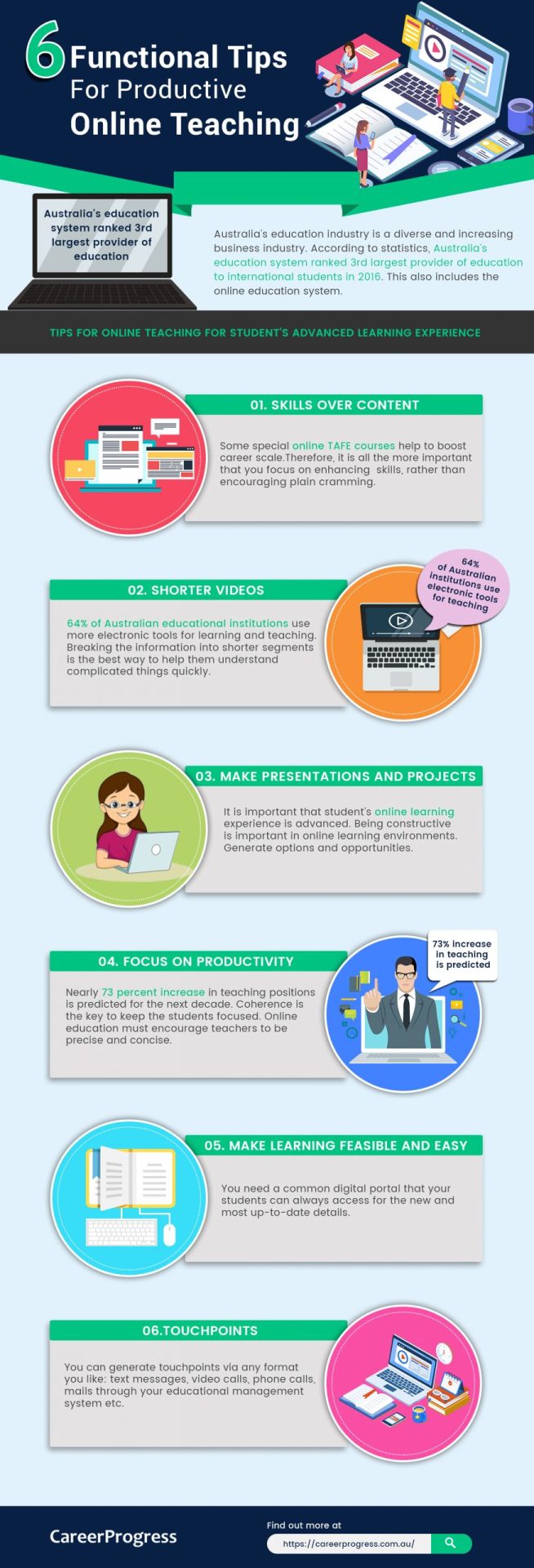6 Functional Tips for Productive Online Teaching
Australia’s education industry is a diverse and increasing business industry. According to statistics, Australia’s education system ranked 3rd largest provider of education to international students in 2016. This also includes the online education system. Currently, due to the pandemic, situations have gotten a bit challenging since the entire system has to be switched to online teaching portals.
Working remotely is a form of job that encourages a worker to operate from basically anywhere — in other words, you don’t have a specific office to which you will report. This will allow people to work anywhere they want, whether from their home or some other country even, etc. Not having your common office is very overwhelming and frustrating for many employees, not just from a technical standpoint, but also from a social perspective. The possible explanation seems to be that innovation is the key focus that enables people to work digitally. If a person’s daily job does not include in-depth technological skills or is very much used to talking face to face, the change to virtual tools for all job-related tasks (along with conferences) via programs may be challenging and inconvenient.
Read Also: Secure Your Job In Covid-19: Useful Online Courses For Uninterrupted Work
It should be of utmost importance that a student’s online learning experience is advanced.

1. Skills over Content
During teaching remotely, handing over study materials to your students and delivering lectures can be done and easily gotten over with. However, it is all about skills. Special online TAFE courses like counselling, business administration, photography, etc. are some of the rare courses that help people boost their career scale. However, they need extra attention. Students not only have doubts, but they would also develop the tendency to make significant mistakes in their respective fields. Therefore, it is all the more important that you focus on enhancing their skills, rather than encouraging plain cramming.
2. Shorter videos
By restricting the length of lecture videos, you are not only delivering quality information but also keeping your student’s interest at heart. 64% of Australian educational institutions use more electronic tools for learning and teaching. However, at an average, a student’s concentration does not remain constant when a video lasts longer than twenty minutes. Instead of doling out an hour-long online class, you could always aim for shorter segments that last ten to fifteen minutes. When a subject is fresh, and you have a new lot to teach, this is the best way to engage students and help them understand the new information effectively. You are no longer teaching them face-to-face, and you won’t be there to personally tackle their problems. Hence, breaking the information into shorter segments is the best way to help them understand complicated things quickly.
3. Make presentations and projects more inventive.
It should be of utmost importance that a student’s online learning experience is advanced. Being constructive is important when developing online learning environments. Planning will require more time and require a great degree of attention to detail. You’re not going to be able to fix errors on the spot or immediately act upon while the students are disconnected.
To efficiently manage your energy, resources, and time, you’ll want to aim for longer, assignments, and projects students that will fetch you time to plan your future lessons and prospects —and that can get your students offline. Focus on working on long-term initiatives where your students have the flexibility and a simple range of objectives and targets that need to be reached. Generate options and opportunities, whenever feasible, for students to share what they are studying with their families and to provide an aspect of student preference to help create more involvement.
4. Focus on Productivity
Innovation and technology will continue to improve education structures and will have an much greater effect in the future. An approximate 73% increase in teaching positions is projected between now and 2030. Every educator knows how to express and explain new lessons to their students. It normally begins with a set of revised and prepared lectures being delivered, followed by an infinite flood of students’ inquiries to explain the following lessons. Although this method may also be stressful, students would still depend on one another and the educator in the classroom when they’re confused.
One of the major drawbacks of online classes is that you and your pupils are no really in the same space to mutually discuss the doubts. Rather, the vast majority of teaching time would ultimately be dominated by activities that involve a higher degree of concentration for self-study. As a consequence, the secret is clarity. It is vital to develop distance educational experiences that have very precise directions and use only single or multiple resources. It is always preferable, whenever necessary, to include tools such as texts as PDFs that pupils can easily download. Bear in mind that basic systems can often entail meticulous work: activities with fewer guidelines sometimes contribute to the higher amount of reasoning and logical thinking, as students try to figure out what they can do under specific frameworks. Distance learning must encourage educators to reflect on how they can be clearer and more succinct in presenting existing and fresh insights.
5. Make learning feasible and easy.
With a sense of practicality, it is important to provide a virtual home base for your pupils. This may be a county-provided integrated learning program, such as Google Classrooms or Canvas, or a self-created classroom platform. In this case, Google Sites are fast, easy-to-use portal.
You need a common digital portal that your students can always access for the new and most up-to-date details. It may be appealing to switch and explore all the interesting educational applications out there — particularly when so many of them are providing free services right now — but usability and accessibility are priceless. Students ought to be confident, returning to the same site, and get exposure to the very same resources. But it should be noted that the more distant you are from your students, the more crucial it is to develop resilience and training standards. In fact, if attendance was a problem before, online education is going to accentuate it. So students need a place to go while they’re out of the system. Maintaining and working for the discrepancies is only going to become difficult because the instructor can not easily participate in person or smaller group coaching. Your students would need to take care of their own training. Your aim should be to create a straightforward structure that will allow them to do just that.
6. Touchpoints
What your pupils are more prone to lack is the personal interaction that is established in your classroom. The little conversations you have with them in corridors, pre and post lectures, or during breaks in courses, are irreplaceable. Although it can be appealing to concentrate better on the material in your online learning projects and video tutorials, it’s more important to build customized touchpoint systems for your students.
You can generate these touchpoints via any format you like: text messages, video calls, phone calls, mails through your educational management system, responses about shared documentation, etc. Create a platform and implement it. Your students are going to see your contribution and realize that you value them.
It is worthwhile to note that it is challenging to develop an interactive distance learning environment. It needs a little time and an excessive amount of discipline. Your students don’t need to feel obligated to log in every day to attend your class; this time should be dealt with utmost value not only by your students but also by you. While it can be challenging to switch to virtual teaching all of a sudden, but it does not have to remain this way, all you need is a little time and prior research. If you’re unfamiliar with this feature, you’ll actually be going to feel like a newly-appointed instructor again. That’s all right! Slowly and steadily, take on every problem, keep interacting with your students, and keep asking them for their valuable feedback on your progress. The students would equally have your back to get you through this phase as long as you are utterly committed to enlightening their minds and not merely deliver a lecture.



